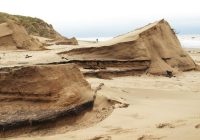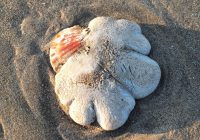Dr Phil Smith’s Wildlife Notes
December 2013
In a year of extreme weather events, December contributed a suitable climax – the biggest storm-surge since 1953. On 5th, a 9.8m tide combined with a severe westerly gale and low atmospheric pressure gave rise to high-water at least a metre above its nominal height. Large waves attacked the dune frontage all along the coast, causing severe damage especially at Formby Point where the dunes have been eroding for a century. Over the next few days I visited several parts of the Sefton Coast to make observations and take photographs. The National Trust frontage at Formby Point had retreated by 10-12m, leaving spectacular sand-cliffs and strange sculptured dune fragments reminiscent of a scene from the Wild West. Equally spectacular were the great blocks of tobacco waste washed out of the dunes and scattered across the beach, while hundreds of tonnes of rubble from the former carpark had collapsed onto the shore off Victoria Road. The disabled-access boardwalk near Lifeboat Road was damaged but not terminally, according to Coast & Countryside staff, while the adjacent Lifeguard lookout post miraculously survived intact.
Meanwhile, at Hightown, the Sailing Club premises were swamped and most of the sand tipped here in 2011 for a coast protection scheme was washed away. It was supposed to last 30 years. The weathered brick-rubble “shingle” beach was driven landwards and it remains to be seen what remains of its classic shingle flora. One of the most upsetting sights here and elsewhere was the enormous quantity of plastic refuse, especially bottle-tops washed up in uncountable numbers. The frontal dune ridge on Crosby beach also lost about 10m but, in absorbing wave energy, probably prevented the promenade being overtopped.
I was also interested to see the impact of the surge on the Green Beach north of Ainsdale-on-Sea. Here the foreshore is much wider, which usually calms the waves. Nevertheless, the youngest dune ridge, previously up to 2.5m high, had been over-washed, losing much of its height, while a slightly older ridge further north was breached in several places, seawater deeply flooding the slack behind.
Great quantities of tidal drift along the beaches included vast numbers of Razor-shells and, at Ravenmeols, my first ever specimen of Dead Men’s Fingers attached to a Scallop shell. Although fairly common and widespread, this relative of corals is mainly associated with rocky shores and was probably washed over from North Wales.
As expected, the gale brought in lots of gulls, a spectacular roost of over 15,000, mostly Herring Gulls, forming on the Ainsdale/Birkdale shore, accompanied by 650 Cormorants and impressive flocks of Oystercatchers. I also spotted an adult Mediterranean Gull at Formby Point, almost exactly where I was shown my first by Maurice Jones in 1969.
December is often a quiet month for birds but the male Baikal Teal at Crossens Marsh attracted large numbers of twitchers. I went to see it on 3rd – an exciting bird but there is always a question mark about the origin of exotic wildfowl. This species breeds in eastern Siberia and should have been wintering in China or Japan. Also visible at distance on Banks Marsh was one of two Great White Egrets on the Ribble. These often roost at dusk with Little Egrets on Southport Marine Lake’s northern island.
A tour of the mosslands inland of Formby produced a flock of 1600 Pink-footed Geese on Downholland Moss, one of them being a strange pie-bald individual. We occasionally see pale sandy-coloured “leucistic” Pinkfeet but this one had big white patches on otherwise normal plumage. The month ended with a magnificent Great Northern Diver on Southport Marine Lake. Occasionally coming close enough to the promenade to photograph, it was actively diving for food every few seconds while being admired by an excited crowd of onlookers. What a bird!




